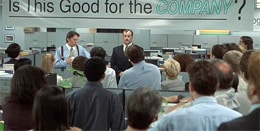
Banners are not an effective way to manage culture change and transformation.
Without a change in culture, most transformation programs such as Lean Six Sigma and portfolio management initiatives often fall short of expectations. So with this in mind, practitioners set out to change the culture – and unwittingly put in place a cycle of failure.
A great example of this can be seen in the film “Office Space.” The film portrays a dismal and dysfunctional corporate culture attempting to get the people to be more focused on the success of the company. How do they go about this? By posting huge banners stating, “Ask yourself, Is this good for the company?”
The problem is we too often confuse the cause and effect. When corporate leaders talk about change, they usually have a desired result in mind. Many argue that the culture is the cause and the organization’s performance is the effect. I’m arguing the opposite: that cultures are developed as a result of, and in response to, the processes and methods of management.
It’s like asking someone at a company, “What’s the purpose of this company?”, and getting the answer, “To make money.” Good answer, some argue. When in reality the answer confuses the purpose with the goal. As far as I know there’s only one organization whose purpose is to make money, and that’s the United States Mint. Peter Drucker was famous for stating “the purpose of business is to get and keep customers.” When we confuse the purpose and the goal we send mixed signals and behaviors go awry as in the cases of Enron and WorldCom and even the fictional Inatech from “Office Space.”
George W. Merck, who led Merck & Co. from 1925 – 52, said “We try to remember that medicine is for the patient, to improve human life. We try never to forget that medicine is for the people. It is not for the profits. The profits follow, and if we have remembered that, they have never failed to appear.”
W. Edward Deming was in such agreement with Mr. Merck, he listed “Constancy of Purpose” first in his famous 14 Points of Management. To Deming, the first priority of management was to create constancy of purpose toward continual improvement of products and service, allocating resources to provide for long range needs rather than only short term profitability, with the aim to become competitive, stay in business and to provide jobs.
So, what is Culture? According to Jeffrey Schwartz, Pablo Gaito, and Doug Lennick[i], Culture develops from beliefs that have been reinforced over the years through everyday routines and hundreds of workplace conversations. They all have the same underlying theme: an organization’s culture can be defined as “The way we do things around here.”
It is developed over time in response to the way the company is managed. According to Six Sigma guru, Mikel Harry, “it takes between three and six years for Six Sigma to become entrenched in even the most progressive organizations.” Why? Because it takes this long for people to become convinced that this is the way things are done around here.
To create constancy of purpose and to convince people of a new way “things are done around here,” we need to examine our methods of management and fundamentally structure them to produce long-term success. From our vision and mission, to the way we define and measure success, all the way to our hiring and pay and promotion schemes.
We see it with customers of Upland PowerSteering. They use our solutions to define the organization’s priorities, to set measurable objectives, and to ensure the projects they work on and the investment decisions they make are aligned and support those objectives. Another excellent example is what Jack Welch instituted at GE. To be eligible for promotion to a management position you must have completed and be certified as a Green Belt in continuous improvement methods. Welch didn’t just hang up a banner; he fundamentally changed the management process by which promotions were decided.
The problem with trying to change culture is that it is such an amorphous and vague characteristic of organizations, it is hard to know what to target and where to begin. It must start with an understanding that culture change will not happen by decree. It only happens in response to our management methods.
To learn more about culture change and transformation in context to your Project Management Office (PMO), be sure to read our White Paper “The Future PMO.” This will give you insights to what your PMO should look like in the future, and how to get there.
[i] Jeffrey Schwartz, Pablo Gaito, and Doug Lennick. “That’s the Way We (Used to) Do Things Around Here.” strategy+business. February 22, 2011. https://www.strategy-business.com/article/11109?gko=642d6

